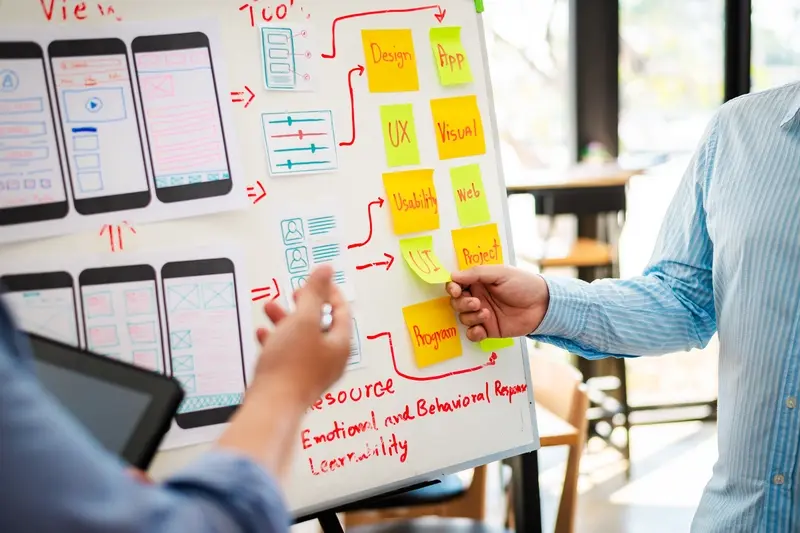How Long Does It Take To Develop An App?
If you're reading this guide, you're probably wondering exactly how long it will take to bring your app idea to life. It's one of the most common questions we hear at Glance, and we completely understand why. Whether you're an entrepreneur with a groundbreaking concept or a business owner looking to expand your digital presence, timing matters tremendously.
The journey of app development is much like building a house - the timeframe depends on how many rooms you want, what luxuries you need, and how detailed your blueprint is.
The truth is, app development timelines can vary significantly - from a few weeks for a basic app to several months or even a year for complex platforms. Think about popular apps like Instagram or Uber; while they seem straightforward now, they've evolved tremendously from their initial versions through years of refinement and updates.
What This Guide Will Cover
Throughout this comprehensive guide, we'll break down each phase of the app development process, helping you understand what influences development time and how to plan realistically. We'll explore everything from initial planning to post-launch support, drawing from our eight years of experience in crafting mobile applications.
Whether you're building a simple productivity tool or the next social media sensation, understanding these timeframes will help you set realistic expectations and plan your project more effectively. We'll also share practical tips for avoiding common delays and optimising your development timeline - without compromising on quality.
Ready to discover what goes into creating your app? Let's begin by understanding the different levels of app complexity and how they affect development timelines.
Understanding App Complexity
When clients ask us how long it will take to build their app, we often smile and reply, "Well, that's a bit like asking how long it takes to build a house." Just as homes can range from simple cottages to sprawling mansions, apps come in various levels of complexity that significantly impact development time.
Let's make this easier to grasp. Think of your favourite apps - perhaps WhatsApp for its messaging or Deliveroo for food ordering. While they might seem straightforward to use, their complexity levels are worlds apart. A simple calculator app might take a few weeks to develop, while a social networking platform could require many months.
Common Complexity Factors
- User authentication and profiles
- Integration with other services or APIs
- Real-time features (chat, notifications)
- Payment processing capabilities
- Offline functionality
- Data encryption and security measures
From our experience working with hundreds of apps over eight years, we've noticed that clients often underestimate their app's complexity. That brilliant idea for a "simple" dating app might actually require sophisticated matching algorithms, chat features, location services, and robust security measures - all of which add to the development timeline.
Understanding your app's complexity early on helps set realistic expectations and prevents surprises later. Remember, complexity isn't necessarily bad - it's often what makes your app unique and valuable. The key is recognising it early and planning accordingly.
Planning and Research Phase
Before a single line of code is written, proper planning and research can make the difference between a six-month development journey and a year-long saga. At Glance, we've seen countless projects where thorough planning saved months of development time - and equally, where insufficient research led to costly delays.
Essential Planning Elements
Think of the planning phase as laying the foundation of a house. You wouldn't start building without blueprints, would you? Similarly, app development requires careful consideration of your target audience, core features, and technical requirements. Just like preparing for a round-the-world trip, you'll need a detailed map of where you're heading.
- Market research and competitor analysis (2-3 weeks)
- User persona development (1 week)
- Feature prioritisation and MVP definition (1-2 weeks)
- Technical requirements documentation (1-2 weeks)
- Project timeline and milestone planning (1 week)
Research Outcomes
This phase typically takes 6-8 weeks, depending on your app's complexity. While it might feel like a long time (especially when you're eager to see your app come to life), remember that every week spent planning can save a month of development headaches later. It's rather like measuring twice and cutting once - a principle that's served craftspeople well for centuries.
Create a detailed requirements document that your whole team can reference. We've found that projects with comprehensive documentation are 70% more likely to stay on schedule.
Design and User Experience
The design and user experience (UX) phase is where your app starts coming to life visually, typically taking between 2-6 weeks depending on complexity. Think of this stage as creating the blueprint for your dream house - you wouldn't start building without proper plans, would you?
The Design Journey
At this stage, we transform your app idea into something tangible through wireframes, mockups, and interactive prototypes. It's rather like sketching out a storyboard for a film - we're planning every screen and interaction before any coding begins. This careful planning helps avoid costly changes later.
Remember those apps you've used where everything just feels... right? That's no accident! Good design takes time, and we've found that rushing this phase often leads to poor user engagement later. Just as you wouldn't serve a half-baked cake, an under-designed app won't satisfy your users.
- Wireframing: 3-5 days
- Visual Design: 1-2 weeks
- Interactive Prototyping: 1-2 weeks
- Design Review and Iterations: 1 week
- UX Testing and Refinement: 1 week
Impact on Development Timeline
Investing proper time in design actually saves time during development. Think of it as measuring twice and cutting once - the clearer your design blueprint, the smoother the development process will be. We've seen projects where skimping on design led to weeks of extra development time, which is why we always emphasise getting this stage right.
Core Development Time
After all the planning and design work is complete, we finally arrive at what most people think of as 'actual' app development. This is where our development team rolls up their sleeves and starts turning those beautiful designs into working code.
At this stage, you're probably wondering exactly how long this part will take. The honest answer is that it varies significantly based on your app's complexity. From our experience working with hundreds of clients over the past eight years, we've found that core development typically takes anywhere from 3-6 months for a medium-complexity app.
The development phase is like building a house - rushing through it might get you a finished product faster, but you'll likely end up with problems that could have been avoided with proper time and attention to detail
What Happens During Core Development?
Think of core development as assembling a complex puzzle. Our developers work on different pieces simultaneously - building the backend infrastructure (the engine of your app), creating the frontend interface (what users see and interact with), and connecting all the various features and functionalities.
For a simple app with basic features, like a to-do list, core development might take 2-3 months. However, if you're building something more complex, like a social networking app or an e-commerce platform with payment processing, expect 4-8 months of development time.
Remember that good things take time. Just as you wouldn't rush a chef preparing a fine meal, rushing through development can lead to technical debt and problems down the line. We've learned that it's better to do things properly the first time, even if it means taking a bit longer.
Testing and Quality Assurance
At this stage of app development, we're rather like food critics at a fine restaurant - we need to ensure everything is absolutely perfect before it reaches our customers. Testing might not sound as exciting as the design or development phases, but it's absolutely crucial for your app's success.
From our experience working with hundreds of apps, thorough testing typically requires about 20-30% of the total development time. Think of it as the difference between a wonky table at your local café and one that sits perfectly stable - it's all in the fine-tuning.
Essential Testing Phases
- Functionality Testing: Checking if every button, form and feature works as intended
- Usability Testing: Real users trying your app to spot any confusion or friction
- Compatibility Testing: Ensuring your app works across different devices and OS versions
- Performance Testing: Measuring speed, responsiveness and resource usage
- Security Testing: Protecting user data and checking for vulnerabilities
We often see clients wanting to rush through this phase, especially when they're excited to launch. However, just as you wouldn't want to serve an undercooked meal to your dinner guests, launching an undertested app can harm your reputation and user trust.
The good news? While testing takes time, it's an investment that pays off enormously. Every pound spent on testing saves roughly five pounds in potential post-launch fixes. Plus, your users will thank you for delivering a smooth, reliable experience from day one.
Common Development Delays
Even with the best-laid plans, app development can sometimes feel like trying to bake a soufflé – one small hiccup and things might not rise as expected. After working with hundreds of clients over the years, we've seen how certain delays can impact development timelines, and we want to help you understand and prepare for them.
The Most Common Setbacks
- Scope creep: When new features keep getting added during development (like trying to add extra toppings to a pizza that's already in the oven)
- Technical challenges: Unexpected compatibility issues or complex integrations
- Communication gaps: Misunderstandings between stakeholders and developers
- Resource availability: Key team members becoming unavailable or falling ill
- Third-party dependencies: Waiting for external APIs or service providers
- Design revisions: Multiple rounds of changes to the user interface
The good news? Most delays are preventable with proper planning. Think of app development like planning a road trip – you might encounter some traffic along the way, but if you've factored in extra time and mapped out alternative routes, you'll still reach your destination without too much stress.
One often overlooked cause of delays is decision paralysis. We've seen projects stall for weeks simply because stakeholders couldn't agree on something as seemingly simple as button colours or menu layouts. That's why having a clear decision-making hierarchy from the start is crucial.
Create a 'change request buffer' in your timeline – we recommend adding 15-20% extra time to your estimated schedule to account for unexpected changes and revisions. This simple step has saved many of our clients from deadline stress!
Making Your App Store-Ready
After months of development, you're probably eager to share your app with the world. However, getting your app store-ready isn't quite as simple as clicking an 'upload' button. Think of it like preparing for a job interview - you need all your documents in order, and everything needs to look spotless.
Essential Store Requirements
Both the Apple App Store and Google Play Store have specific requirements that your app must meet. You'll need compelling screenshots, an eye-catching icon, and a description that clearly explains your app's value. It's rather like crafting the perfect CV - every element needs to work together to make a brilliant first impression.
The Review Process
Here's something many developers don't realise: the app store review process can take anywhere from a few days to several weeks. Apple, in particular, is known for their thorough review process, checking everything from technical performance to content appropriateness. We've seen perfectly good apps get rejected for seemingly minor issues, like having a slightly blurry icon!
To avoid delays, ensure you've prepared all the necessary assets and documentation beforehand. This includes privacy policies, age ratings, and any special permissions your app might need. Remember those forms you had to fill out for your passport? It's a bit like that - missing information can hold up the whole process.
The key is to treat this phase as seriously as the development itself. A well-prepared submission can significantly reduce the time between completion and launch, getting your app into users' hands more quickly. After all, the finish line isn't when your app is built - it's when users can download it.
Post-Launch Updates and Support
Launching your app is a bit like sending your child off to their first day of school - it's just the beginning of the journey, not the end. At Glance, we've learned that post-launch support typically requires about 15-20% of your initial development time each year to keep your app healthy and growing.
Essential Post-Launch Activities
In the first few months after launch, you'll need to monitor user behaviour, collect feedback, and address any unexpected bugs that pop up. Think of it as your app's settling-in period - just like when you move into a new home and discover little things that need fixing.
The most successful apps we've worked with aren't the ones that launched perfectly, but the ones that listened to their users and evolved consistently
Ongoing Maintenance Requirements
Regular updates are crucial for keeping your app relevant and secure. Operating system updates (like iOS and Android's yearly releases), security patches, and performance optimisations typically require attention every 2-3 months. We've found that most successful apps roll out feature updates every 4-6 weeks, with smaller maintenance updates happening more frequently.
Remember those lovely vintage cars that require constant maintenance to keep running smoothly? Modern apps aren't much different. They need regular care, updates, and improvements to stay competitive and functional. Setting aside both time and budget for post-launch support isn't just good practice - it's essential for long-term success. We typically recommend allocating about 20% of your initial development budget annually for maintenance and updates.
Ways to Speed Up Development
We understand that time is precious, and you're likely eager to get your app into users' hands as quickly as possible. After working with hundreds of clients over the years, we've discovered several reliable methods to accelerate app development without compromising quality.
Start Smart, Move Fast
Think of app development like building a house - the better your blueprint, the smoother the construction. Creating detailed specifications and wireframes upfront might feel time-consuming, but it's like having a good map before a journey - you'll actually move faster and avoid wrong turns. We've seen projects save weeks or even months simply because they started with crystal-clear requirements.
Practical Time-Saving Approaches
Consider starting with a Minimum Viable Product (MVP) - it's like testing a recipe with basic ingredients before adding fancy spices. You can always add more features later based on real user feedback. Using pre-built components and frameworks can also significantly speed things up - there's no need to reinvent the wheel for common functions like user authentication or payment processing.
Another often-overlooked time-saver is running parallel development tracks. While your backend team works on server architecture, your design team can simultaneously craft the user interface. It's rather like having different chefs prepare different courses of a meal at the same time.
Remember, faster doesn't always mean better. The key is finding the sweet spot between speed and quality. Sometimes, taking an extra week during planning can save a month of revisions later. From our experience, the most successful projects are those that maintain a steady, well-organised pace rather than those rushing to the finish line.
Conclusion
After exploring the various phases and factors that influence app development timelines, it's clear that creating a successful app isn't a quick weekend project - it's more like preparing for a marathon than a sprint. Just as every journey is unique, each app's development timeline will vary based on its complexity, features, and specific requirements.
We understand that waiting for your app to come to life can feel like watching a kettle boil, especially when you're excited about your idea. From our eight years of experience working with startups and established businesses alike, we've learned that successful apps typically take anywhere from 4 to 9 months to develop properly. However, remember that rushing through development to meet an arbitrary deadline often leads to poor user experience and costly fixes down the road.
The key takeaway is to focus on quality over speed. Think of app development like building a house - you wouldn't want your builder to skip the foundations just to finish faster! Take time to plan thoroughly, invest in good design, implement proper testing, and prepare for post-launch support. These steps might seem time-consuming initially, but they're essential for creating an app that your users will love and trust.
Whether you're dreaming of the next Instagram or building a simple business tool, remember that the most successful apps are those that prioritise user needs and maintain high-quality standards throughout development. The time investment you make today will pay dividends in the future success of your application.
Share this
Subscribe To Our Learning Centre
You May Also Like
These Related Guides

How Does the App Development Process Work?

What's The Difference Between In-App Support And External Help Desks?



